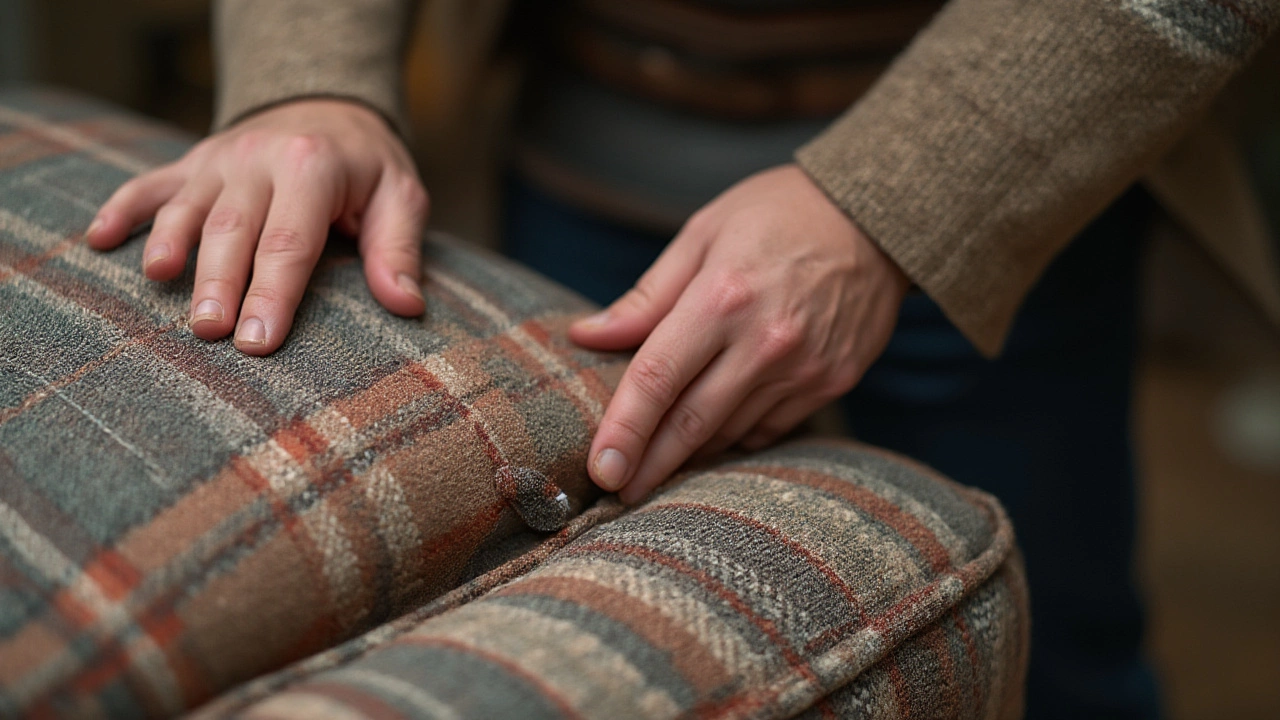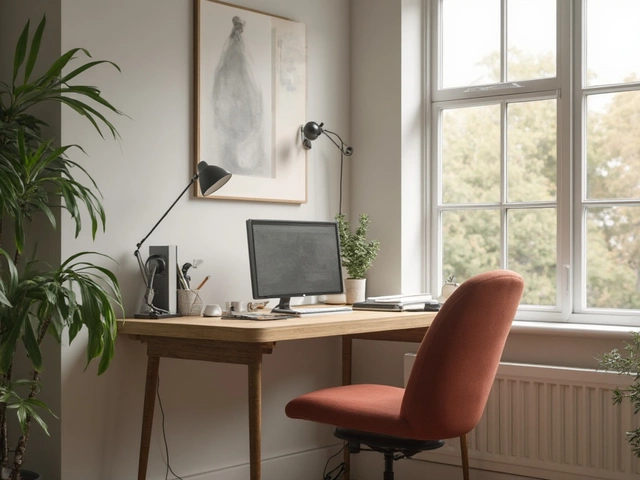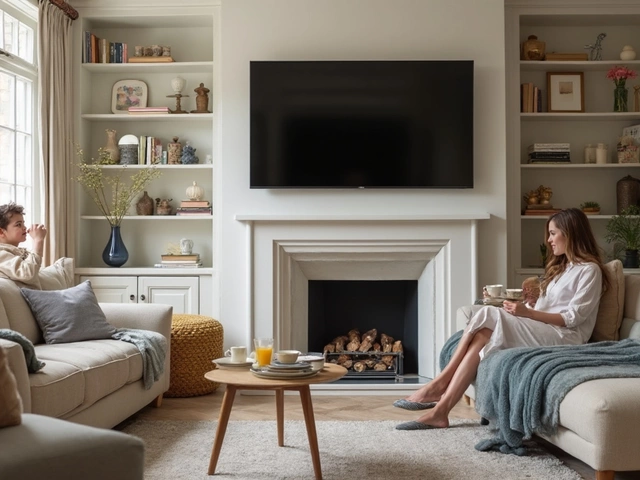 24
Jul,2025
24
Jul,2025
They say the living room is the heart of the home, but let's be real—it's the couch that runs the show. A good couch is where families pile up after a long day, epic movie marathons unfold, and pets sneak in a snooze when no one’s looking. Here’s the problem: not every couch that looks plush or trendy can actually stand up to food stains, rambunctious kids, or the test of time. Ever wondered why your last 'bargain' sofa started sagging within a year, while Nana’s vintage piece still looks almost new decades later? The devil’s in the details— construction, materials, and a few secrets most salespeople won’t tell you. Cracking these codes can save you a fortune and a heap of regret.
What Materials Make (or Break) a Couch
First things first: a couch is only as good as what’s hidden underneath. The part you see—the fabric or leather, the color, the cushions—is just the tip of the iceberg. Ever heard of kiln-dried hardwood? That’s the gold standard for couch frames. Unlike green wood, kiln drying zaps away moisture, making frames less prone to warping, cracking, or wobbling when you move it around. It sounds fancy, but ask your local furniture store and you’ll find out—it’s genuinely a mark of quality. Compare that to softwoods like pine, which can work but aren’t nearly as tough. Metal frames exist too, but unless it’s stainless steel, they're usually a sign of cost-cutting.
Jumping to what holds the whole seat up—look for eight-way hand-tied spring systems. It’s a classic upholstery trick: skilled workers knot springs in a crisscross pattern, making the seat comfy and resilient. If that’s a bit much for your budget, drop-in sinuous springs (the zig-zag kind) are okay, but they can lose their bounce over time. And if you see words like 'mesh' or 'webbing' with nothing else, beware. Those tend to sag fast.
With cushion filling, it’s all about balance. Pure down sounds luxurious, but gets squashed and lumpy unless mixed with foam. The sweet spot: a high-resilience polyurethane foam core wrapped in a down or feather blend. This combo stays firm but still feels soft. And don’t forget the upholstery. Genuine leather keeps getting better with age (and survives the occasional spilled drink). For fabric, woven blends score points for toughness, especially with tight weaves and stain-resistant treatments. Loose weaves and delicate prints? They’re stylish but rarely built for daily use.
Here’s a quick cheat sheet for couch materials:
| Component | Best Choice | Budget Friendly | Avoid |
|---|---|---|---|
| Frame | Kiln-dried hardwood | Engineered wood | Softwood, particleboard |
| Springs | 8-way hand-tied | Zig-zag (sinuous) | Mesh/webbing only |
| Cushions | HR foam + down wrap | Foam only | All down |
| Upholstery | Top-grain leather, woven fabric | Synthetic blends | Thin leather, loose weave |
How to Test Couch Construction—Without Breaking It
No need to whip out a drill or screwdriver at the store. There are ways to sniff out a well-built couch right there on the showroom floor. First, lift a corner. Feel heavy and solid? Good sign. Flimsy and featherweight? Probably stuffed with plywood, plastic, or hollow additions. Slide your hands underneath and along the sides. A strong couch shouldn’t creak or flex. If you notice give, that’s a red flag.
Next, sit on several different spots. Does it feel consistent—no weird valleys or odd squeaks? If you feel the frame digging into your legs or back, pass on it. The arms and backrest should stay firm under pressure, not wobble or move.
Want to go the extra mile? Ask a salesperson if you can unzip a cushion and peek inside. Some makers even let you flip the couch to check out the bottom. You’re looking for tidy craftsmanship: no stray staples sticking out, and fabric pulled tight, not loose or baggy. Exposed staples, lumpy stitches, or glue marks point to rushed assembly and are rarely found in high-quality models.
Construction quality isn’t just about comfort today; it’s about how the couch handles years of Netflix binges or kids using it as a trampoline. Melbourne’s summer humidity can make cheap joints loosen or warp, so buy with our local climate in mind. Look for signs of corner blocks (those little wood wedges inside the frame) and double dowel joints—they help the sofa handle weight and movement far better than staples or nails alone.
Check leg attachment too. Screw-in or bolted legs are sturdier than legs simply glued or nailed on. And if a sofa comes with removable legs, make sure those joints are tightly reinforced. It sounds nit-picky, but those are the spots that usually give up first.

Hidden Features That Define Long-Lasting Sofas
Makers of top-tier sofas aren’t afraid to get nerdy with details most folks never even see. Zippers on cushions? Not just for washing covers—they make it easier to replace worn filling down the track. Double-stitched seams aren’t just for denim; on sofas, they survive years of tension and accidental tugs. If your kids love to dig between couch cushions for 'lost' snacks or phones, you’ll appreciate tough seams.
Detachable back cushions are another win. Not only are they easier to flip and plump (so you don’t get that permanent crater), but you can take the covers off for cleaning. Fixed-back sofas are tidier for formal lounges, but a family couch should have some flexibility.
You know those loose threads that tickle your legs? Not good. High-end makers snip such flaws before sending their furniture out. If your potential new couch sports messy welting (that piping around the edge) or uneven edges, it’s usually a sign of careless quality control.
Want bonus points? Check out the warranty. A quality sofa brand often backs their couches with at least 10-15 years on the frame, and 2-5 on cushions and fabric. If you see only a one-year, 'limited' warranty, odds are the company isn't betting on longevity.
Some brands are now eco-friendly, seeking certified sustainable wood and low-VOC glues. In Australia, look for the FSC (Forest Stewardship Council) certification when you want to buy responsibly. An added benefit—these eco sofas often have better air quality at home (no weird off-gassing chemicals).
high-quality couch hunting isn’t always about style. It’s these hidden features—stitching, cushion design, and even how the frame's put together—that can separate a buy-it-once masterpiece from the kind you’re replacing every couple of years.
When Sofas Go Digital: New Trends That Signal Quality (or Not)
It’s 2025, and the world of sofas isn’t standing still. Now there’s talk of stain-repellent nanotech fabric (seriously, red wine slides right off) and smart fabrics that monitor temperature. While these upgrades are cool, don’t let tech dazzle distract you from the fundamentals above.
Online retailers are pushing augmented reality—see how a sofa fits in your living room through your phone. Great for visualizing color and shape. But if you can’t sit, touch, or bounce on it first, you’ve got to dig even deeper into user reviews, return policies, and detailed product specs. 'Free shipping' won’t matter if you’re stuck with a lemon.
Latest trend: modular sofas, with swappable arms, backs, and cushions. The best of these are reinforced right at the join, so no wobbly bits, even after years of rearranging. But the cheap imitations skimp on connectors or use thin metal clips that give up too soon. Ask to test before you drop your dollars.
The pandemic sent couch-shopping online, but physical stores are still where you’ll find the best test-drive opportunities. In 2024, consumer reports ranked in-store sofa shoppers as being twice as satisfied with their choices. It’s not just a numbers game; when you see and touch, you spot quality with your senses. But if you’re ordering online, seek out close-ups of zippers, seams, and cushion cross-sections. Brands that show full construction photos and offer in-home trials tend to be more confident in what they’re selling.
One new stat worth knowing: recent surveys show Aussies keep their main sofa for 10 years, but buyers who invest a bit more in quality tend to keep theirs for up to 20. That’s two decades of game nights, study sessions, midnight snacks, and—let's be honest—accidental food spills. Skimp on quality, and you’re gaming with the odds in favor of landfill rather than legacy. Choose wisely, and that couch becomes the backbone of your home’s personality.




